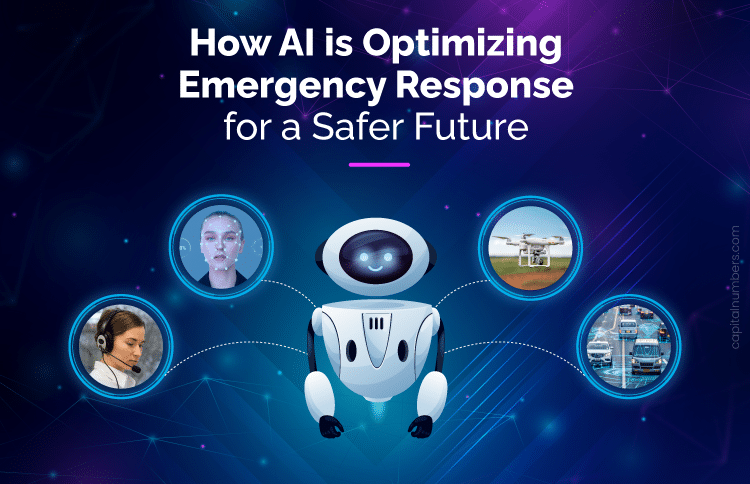How AI is Optimizing Emergency Response for a Safer Future
Table of Contents
When disasters strike, every second is crucial. Traditional emergency methods, while helpful, often can’t keep up with the fast-changing nature of crises. That’s where Artificial Intelligence (AI) comes in. AI is revolutionizing how we prepare for, respond to, and recover from emergencies. With tools like predictive analytics and real-time data processing, AI is transforming emergency management right now.
Imagine a world where AI can forecast natural disasters before they happen, where drones with facial recognition can find missing people quickly, and where personalized alerts guide you to safety accurately. This isn’t science fiction; it’s happening today. As we move into this new era of emergency response, it’s vital to see how AI is enhancing every aspect, making our future safer.
In this blog, we’ll explore the incredible ways AI is changing emergency response. We’ll discuss the key technologies driving this transformation, the benefits and challenges of using AI in emergencies, and real-world examples of AI in action. Join us as we explore how AI is making our world safer through innovative advancements in emergency response.
Applications of AI in Emergency Situations
In this section, we will explore various emergency scenarios where AI can play a crucial role. From natural disaster management to enhancing medical responses, we will examine how AI is revolutionizing crisis management across different situations.
Predictive Analytics for Disaster Preparedness
AI leverages predictive analytics to assess and anticipate potential disasters. By analyzing historical data and environmental factors, AI algorithms can identify high-risk areas and predict the likelihood of natural disasters such as floods, wildfires, or hurricanes. This foresight enables proactive measures for disaster preparedness and evacuation planning.
Automated Emergency Call Handling
AI streamlines emergency call handling by automating initial responses. Natural Language Processing (NLP) algorithms can understand and categorize emergency calls, providing critical information to dispatchers and emergency services more efficiently. This automation reduces response times and ensures a faster deployment of resources to the scene.
Facial Recognition for Missing Persons
In cases of missing persons or disasters, AI-powered facial recognition technology plays a crucial role. Automated systems can analyze vast databases of images to identify and locate missing individuals. This capability expedites the search and rescue process, increasing the chances of reuniting families during critical situations.
Drone Technology for Search and Rescue
Drones equipped with AI are revolutionizing search and rescue operations. AI algorithms enable drones to analyze terrain, identify survivors, and navigate challenging environments. This technology enhances the efficiency and coverage of search and rescue missions, especially in areas that are difficult to access by traditional means.
Fall Detection and Emergency Assistance
In healthcare settings, AI-powered fall detection systems contribute to rapid emergency response. Wearable devices or smart home sensors can detect falls and automatically trigger emergency alerts. This swift response is particularly valuable for the elderly or individuals with medical conditions who may require immediate assistance.
Intelligent Traffic Management during Emergencies
AI optimizes traffic management in emergency situations. Smart algorithms can analyze real-time traffic data, rerouting vehicles to ensure the smooth flow of emergency services. This intelligent traffic management enhances the speed at which emergency responders can reach their destinations, minimizing delays and improving overall response effectiveness.
Virtual Emergency Chatbots
AI-driven chatbots provide virtual assistance during emergencies. These chatbots can offer immediate guidance on basic first aid, evacuation procedures, or provide real-time information about emergency shelters. Virtual emergency assistants complement human efforts, disseminating critical information to a wide audience in a timely manner.
How AI-Based Applications Enhance and Accelerate Emergency Support
In this section, we will explore how AI-based applications work to provide better and faster emergency support. We will cover key aspects such as data collection and analysis, machine learning and predictive analytics, natural language processing (NLP), and more.
Data Collection and Analysis
- Sensors and IoT Devices: AI systems utilize various sensors and Internet of Things (IoT) devices to collect real-time data from multiple sources. This includes weather stations that monitor atmospheric conditions, seismic sensors that detect earthquake activity, cameras that capture live images and videos, and social media platforms where people share updates and information.
- Data Integration: AI combines data from these different sources to create a comprehensive and accurate view of the situation. By integrating information from weather reports, seismic readings, visual data, and social media posts, AI systems can provide a holistic understanding of emergencies as they unfold.
Machine Learning and Predictive Analytics
- Pattern Recognition: AI uses machine learning algorithms to analyze the collected data, identifying patterns and anomalies that might indicate an emerging emergency. For example, a sudden increase in social media posts about an earthquake in a specific area can signal the need for immediate response.
- Predictive Modeling: AI systems create predictive models to forecast the development and potential impact of disasters. These models can predict the path of hurricanes, the likelihood of aftershocks following an earthquake, or the potential flooding areas during heavy rainfall, helping authorities prepare and respond more effectively.
Natural Language Processing (NLP)
- Social Media Monitoring: AI employs natural language processing to monitor social media platforms for real-time information on unfolding events. By analyzing posts and tweets, AI can gauge public sentiment, identify urgent needs, and detect misinformation.
- Automated Messaging: AI generates and sends out automated alerts in multiple languages and formats. This ensures that critical information reaches a diverse audience quickly and efficiently, helping people take necessary precautions or evacuate if needed.
Geospatial Analysis
- Mapping and Visualization: AI leverages Geographic Information Systems (GIS) to map affected areas and visualize data. This helps emergency responders understand the geographical spread of a disaster, such as the extent of floodwaters or the areas most affected by an earthquake.
- Location-Based Alerts: AI sends targeted alerts to people based on their specific locations. For instance, residents in flood-prone areas can receive warnings and evacuation instructions tailored to their precise location, ensuring timely and relevant information delivery.
Decision Support Systems
- Recommendation Engines: AI provides actionable insights and recommendations to emergency responders and decision-makers. These recommendations can include the best evacuation routes, resource allocation strategies, and immediate actions to mitigate damage.
- Scenario Simulation: AI runs simulations to predict the outcomes of various response strategies. By simulating different scenarios, such as evacuation plans or resource distribution methods, AI helps authorities make informed decisions that can save lives and minimize damage during real emergencies.
You May Also Read: How Does IoT Empower Disaster Management with Real-Time Data
Benefits of Using AI in Handling Emergency Situations
In this section, we will discuss the various benefits of using AI in handling emergency situations. Key advantages include speed and accuracy, customization, resource optimization, and enhanced public engagement.
Speed and Accuracy
- Processing Large Volumes of Data Quickly: AI can analyze vast amounts of data in real-time, such as weather patterns, social media updates, and sensor readings. This rapid processing capability ensures that alerts and information are disseminated quickly, which is crucial in emergencies where every second counts.
- Ensuring Timely and Precise Alerts: By continuously monitoring and analyzing data, AI systems can detect anomalies and potential threats with high accuracy. This enables the issuance of precise alerts, reducing false alarms and ensuring that the right information reaches the right people promptly.
Customization
- Tailored Alerts for Specific Regions: AI can customize alerts based on geographic regions, taking into account local conditions and vulnerabilities. For instance, residents in coastal areas can receive specific warnings about tsunamis or hurricanes, while those in earthquake-prone zones get alerts tailored to seismic activity.
- Meeting Individual Needs and Vulnerabilities: AI systems can also consider the specific needs and vulnerabilities of individuals. For example, alerts can be customized for elderly individuals, people with disabilities, or those with specific health conditions, ensuring that everyone receives relevant and actionable information.
Resource Optimization
- Efficient Allocation of Resources: AI can predict where resources will be most needed during an emergency by analyzing patterns and trends. This helps in the efficient deployment of emergency personnel, medical supplies, and rescue equipment, ensuring that critical resources are available where they are needed most.
- Reducing Waste and Maximizing Impact: By optimizing resource allocation, AI helps reduce waste and maximize the impact of emergency response efforts. This ensures that limited resources are used effectively, ultimately saving more lives and reducing the overall impact of disasters.
Enhanced Public Engagement
- Improved Communication Strategies: AI can enhance communication strategies by analyzing public sentiment and engagement levels. This enables authorities to craft messages that resonate with the public, increasing the likelihood of compliance with emergency instructions.
- Building Public Trust and Compliance: Effective communication, backed by AI-driven insights, helps build trust between the public and emergency responders. Clear, accurate, and timely information fosters a sense of confidence, encouraging people to follow instructions and cooperate during emergencies.
By leveraging AI’s capabilities in these areas, emergency response efforts can become more efficient, effective, and tailored to the needs of diverse populations, ultimately leading to better outcomes during critical situations.
Are you planning to build intelligent software systems to automate your business processes? Contact us to learn more about our AI/ML Development Services.
Challenges and Considerations of Using AI in Handling Emergency Situations
Data Privacy and Security
AI systems in emergency response gather vast amounts of data, including personal information from social media, medical records, and real-time location tracking. Protecting this sensitive information from unauthorized access and breaches is crucial. Ethical considerations in AI software development play a key role in ensuring data privacy and security. Implementing robust encryption methods, secure data storage solutions, and stringent access controls are essential to maintaining this protection.
Bias and Fairness
AI algorithms are trained on historical data, which can sometimes contain biases. If not properly addressed, these biases can lead to unfair treatment of certain groups during emergencies. For instance, facial recognition technology might be less accurate for people with certain skin tones. Ensuring fairness requires continuous evaluation and adjustment of AI algorithms, incorporating diverse data sets, and involving ethicists in the development process to mitigate biases.
Infrastructure
Implementing AI in emergency response necessitates a robust technological infrastructure. This includes high-speed internet, powerful computing resources, and reliable communication networks. Developing and maintaining such infrastructure can be challenging, especially in remote or underdeveloped areas. Investment in technology, regular updates, and maintenance are necessary to ensure the AI systems function efficiently during emergencies.
Public Trust
For AI to be effective in emergency situations, it is vital that the public and emergency responders trust these systems. Building this trust involves transparent communication about how AI systems work, how data is used and protected, and the benefits of using AI in emergencies. Additionally, involving community leaders and emergency personnel in the development and deployment of AI solutions can help build credibility and acceptance. Regular audits, ethical reviews, and public education campaigns are also important to maintain and enhance trust over time.
Conclusion
Artificial Intelligence is changing how we respond to emergencies, making the process faster and more efficient. With tools like smart alerts, predictive analytics, facial recognition, and drones, AI helps create safer and more resilient communities. As technology improves, using AI in emergency response will save more lives and help communities recover faster from unexpected disasters.
However, it’s important to consider privacy and ethical issues. We need to balance using AI for public safety with protecting people’s privacy. Clear communication about how data is used and following ethical guidelines will ensure AI is used responsibly in emergencies.

















